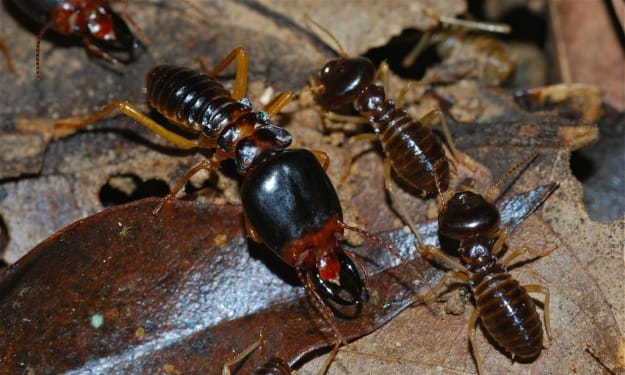Embarrassing microscope videos reveal that strawberries are teeming with bugs.
Why Do Strawberries Have Bugs?

Although strawberries may seem like a healthy food, the typical ripe fruit may be home to a vermin feast. Fruit lovers are frightened by a disturbing video that surfaced on Twitter and showed the juicy red fruit teeming with microscopic creatures of biblical plague proportions.
"How's your day going today? The caption to the video, which has received over 2.5 million views on the platform, apologizes for ruining the moment by showing a strawberry under a microscope.
In the disturbing video that follows, a scientist removes a slice of a strawberry and examines it under a microscope as menacing music plays in the background. When the camera switches to a magnifier's eye view, it reveals tiny, colorful creatures that resemble mites darting across the surface.This is why you most always wash your fruits!”
This is a trend that related TikTok videos that have been popular since the pandemic. Users of the app could be seen dipping strawberries in salt water, then reacting in horror as tiny worms burst out of the fruit like something out of "Monsters Inside Me."
Seleste Radcliffe, a TikTok user, says in one clip as she dumps a box of strawberries into a bowl of salted water, "Apparently if you wash your strawberries in water and salt, all the bugs will come out — which, I didn't even know there were bugs in there." She draws attention to some suddenly moving specks on the otherwise healthy-looking strawberries by saying, "Look at that, look at that."

The spotted wing drosophila, a "very tiny" invasive fruit fly that prefers to lay its eggs under the skin of strawberries and other berries, is what it turns out to be, and it is the one that is colonizing the strawberries. These transform into larvae, which emerge from the skin like creepy pinatas.
According to Everyday Health, scientists reassure berry lovers that they have nothing to fear despite their nauseating reproductive methods. For one thing, according to Iowa entomologist Don Lewis, "the larvae will be one-fiftieth of an inch — not even visible to the naked eye." According to him, even if we could identify them, it's unlikely that fruit from the grocery store would contain them because refrigeration kills them.

The only surefire way to see the creatures is to leave this disgusting treat out at room temperature for one to two weeks, during which time the flies will develop to a size of one-sixteenth of an inch. However, according to Lewis, the berry will already be rotten and inedible by that point.
Most importantly, there is no evidence that eating these fruit invaders, which are an inevitable part of eating food grown in a field, is harmful. According to Sriyanka Lahiri, an entomologist at the University of Florida, "the reality is that most fruits, stored grains, they have some level of insect infestation that is impossible to get rid of." Lahiri made this statement to USA TODAY in 2020.
Therefore, experts advise against using the saltwater treatment on strawberries, a method of pest detection frequently used by commercial fruit growers, as this will probably make the berries taste infinitely worse than a few bugs.

How Can Bug Infestations Be Prevented in Berries?
Since there is nothing that can be done once the ripe, undamaged fruit has been infected with SWD, pest management strategies are centered on observation and preventative measures to get rid of the adult flies.
The aim, according to Lahiri, is to prevent the females from laying eggs on the fruit. Because these flies are drawn to the smell of fermenting fruit, timely picking of ripe fruits, removal of rotting fruits, and burial of damaged fruits are good cultural practices to control SWD.
Depending on the type of infestation, management recommendations change, but typically call for removing infested plants and using insecticides as needed to protect the fruit.
According to the SWD management bulletin, traps should be checked weekly beginning with the development of fruit until the end of harvest to monitor fields for SWD. Following SWD detection, the following management techniques were advised:
Exclusion netting is used to physically keep pests away from fruit.
Methods of cultural control, such as pruning
decreasing the time between harvests
removing leftover fruit from the plant to keep it tidy
Use of insecticides (compliant with the National Organic Program for organic fruits) as required
Are There Any Health Risks if You Eat the Bugs in Strawberries?
There's no proof that consuming a few maggots with your fruit has any negative health effects—and people have probably been doing it for centuries. So try to forget everything you've just read and carry on eating them.
"Although the sight of translucent worms crawling out of a fresh strawberry fruit might not be appealing, there are no known ill effects of eating them," said Lahiri. "In fact, if you accidentally consumed some maggots, all you did was get some extra animal protein in your salad or fruit shake."
A Brief Overview
Bugs frequently find their way into fruits. But that doesn't necessarily mean they'll hurt you. There is no evidence that strawberry bugs harm your health in any way. Although it may be unpleasant to see the bugs emerge from the strawberry, they have no negative effects on your health.
How do you feel? Send in a comment.
About the Creator
Jacob Damian
Whether you're looking to learn something new, explore different perspectives, or simply satisfy your curiosity, I can offer you insights and perspectives that you may not have considered before. With my ability to process and analyse.






Comments
There are no comments for this story
Be the first to respond and start the conversation.